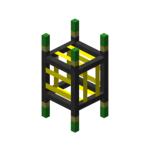Routed Crafting Pipe
| Type |
Multipart Block? |
|---|---|
| Physics |
No |
| Transparency |
Yes |
| Luminance |
? |
| Blast resistance | |
| Tool |
Any tool |
| Renewable |
Yes |
| Stackable |
Yes (64) |
| Flammable |
No |
| Availability |
Survival |
| First appearance | |
| Drops |
Itself |
| Name |
routed_crafting_pipe |
Obtaining
Crafting
Lua error: callParserFunction: function "#dplvar" was not found.
Usage
The routed crafting pipe acts in a similar way to a broadcast chip in a Routed Interface Pipe. It tells the network that, if the materials listed at the top of the GUI are sent to it, it will be able to retrieve the item shown below from a connected inventory.
Using these, on the simplest level, requires a machine that accepts input and output from the same side. The best example of such a machine is an autocrafting table from Buildcraft. If the recipe is set on the autocrafting table, the user simply needs to place one of each required resource for the recipe into the slots at the top of the crafting pipe's GUI (The item is not consumed). Then, use left click on each resource to set the number required. Left click increases the number by 1,and right click decreases. Holding shift changes the number 10. Finally, place one of the output item into the bottom slot, and set the number to however many the crafting recipe produces.
Following this, on a connected Routed Request Pipe GUI, the output item will show as quantity 0 (provided there is no other stock of this item on the system), and any request made will send the required resources to the crafting pipe, provided they are all available. The crafting pipe will then remove the requested number of crafted items from the autocrafting bench, and send them to request pipe. The same works for Stock Keeper Chips in interface pipes. Items sent to a Crafting Pipe are considered to be "Active" and therefore travel very fast.
Crafting pipes can request product from other crafting pipes. For example, if a crafting pipe was set up to produce sticks from planks, and another to produce planks from logs, sticks could still be requested, even if there were no planks available in the system. This allows for systems that only store raw materials to be capable of delivering items with complicated crafting procedures to request pipes or stock keeper chips on demand.
The vast majority of machines do not accept input and output on the same side. The solution to this is to use Routed Extension Pipes. These allow the crafting pipe to route it's required resources to another place, allowing the crafting pipe to be used solely for output.
A crafting pipe will not remove additional product from the machine. It is therefore often best to have an Extractor Chip in an interface pipe connected, with filters set up to remove any leftovers from the machine. As extractor chips are slower to take items from inventories than crafting pipes, this system can be made to work without any chance of failure.
History
| Version | Changes |
|---|---|
| v4.0.0 | Added the Routed Crafting pipe. |


